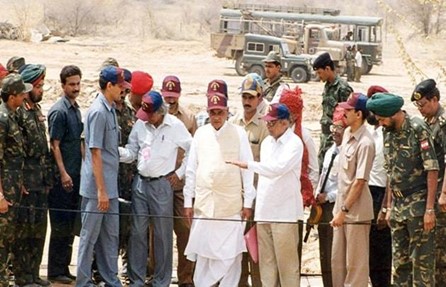- Courses
- GS Full Course 1 Year
- GS Full Course 2 Year
- GS Full Course 3 Year
- GS Full Course Till Selection
- Answer Alpha: Mains 2025 Mentorship
- MEP (Mains Enrichment Programme) Data, Facts
- Essay Target – 150+ Marks
- Online Program
- GS Recorded Course
- Polity
- Geography
- Economy
- Ancient, Medieval and Art & Culture AMAC
- Modern India, Post Independence & World History
- Environment
- Governance
- Science & Technology
- International Relations and Internal Security
- Disaster Management
- Ethics
- NCERT Current Affairs
- Indian Society and Social Issue
- NCERT- Science and Technology
- NCERT - Geography
- NCERT - Ancient History
- NCERT- World History
- NCERT Modern History
- CSAT
- 5 LAYERED ARJUNA Mentorship
- Public Administration Optional
- ABOUT US
- OUR TOPPERS
- TEST SERIES
- FREE STUDY MATERIAL
- VIDEOS
- CONTACT US
25TH Anniversary of Pokhran-II
25TH Anniversary of Pokhran-II


Latest Context
On 11 May 2023, Pokhran-II also known as Operation Shakti was conducted. It was a series of five nuclear bomb test explosions that was conducted at the Indian Army’s Pokhran Test Range. Pokhran-II was the second nuclear test, the first was Pokhran-I whose code name was Smiling Buddha. Through these tests, India displayed its capability to build fission and thermonuclear weapons with a yield of up to 200 kilotons.
Historical Background
The nuclear program of India can be traced to the work of physicist Homi J. Bhabha. He successfully inspired India’s biggest industrial family, the Tatas, to establish the Tata Institute of Fundamental Research (TIFR) in Bombay in 1945. It was India’s first research institution dedicated to the study of nuclear physics. Bhabha served as the founding director of TIFR. Department of Atomic Energy (DAE) was founded, with Bhabha as its director in 1954.
Need to Operation Shakti
There are various factors that demanded the necessity to conduct Operation Shakti which are as follows
- The collapse of the Soviet Union in early 1990 led to the adverse security environment
- Failure by states possessing nuclear weapons to accept a time-bound framework for nuclear disarmament along with a Comprehensive Test Ban Treaty.
- Crushing defeat of India in the 1962 Sino-Indian War played a very crucial role in India’s nuclear program.
- Additionally, China’s subsequent nuclear bomb test at Lop Nor in 1964 further accelerated India’s nuclear program.
- India went to war with Pakistan once again in 1965 and China openly supported Pakistan this time.
- India’s geographical location i.e., surrounded by two adversary nations pressurize India to take necessary steps towards building self-sufficiency.
- To utilize nuclear power and energy for India's development
Impact of Operation Shakti
Operation Shakti impacted India in many ways which are as follows
- The tests allowed India to establish a credible nuclear deterrence and stand up to nuclear blackmail from the West.
- Laid the foundation for achieving self-reliance in the development of nuclear weapons.
- Pokhran-II had a significant impact on India's geopolitical influence because it raised the country's profile as a strategic player in South Asia and the world.
- The nuclear tests led to the development of India's nuclear doctrine, which outlines the country's stance on the use of nuclear weapons and its nuclear posture
- It invited sanctions from some countries especially the US but the condemnation was far less than in 1974.
- It helped India in entering the highly guarded club of countries with the capability to deploy nuclear weapons to cement its status as a dominant nation-state.
India’s Nuclear Doctrine
India presented its nuclear doctrine in 1999. Main features of this doctrine are as follows
- Main objective of India’s nuclear deterrence is to deter adversaries’ use or threat of use of nuclear weapons.
- It highlighted a credible minimum deterrence (CMD) and a no-first-use (NFU) policy and at the same time supported non-proliferation and universal disarmament.
- It changed India’s image and the US (once an adversary of India’s nuclear programme) signed a civil nuclear deal with India in 2008 by recognizing India as a responsible nuclear player.
Way Forward
India should take necessary actions in order to deal with the immediate threats posed by its potential adversary nations by building credible, effective, and sufficient retaliatory capabilities. Another significant measure is India should use its diplomacy very effectively to deal with the threats that come from external powers to maintain the peace and stability necessary for India’s holistic and inclusive development.



